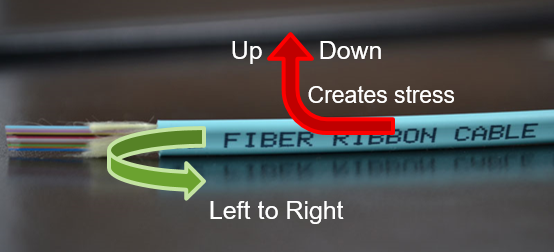Ribbon Fiber Pros & Cons
On the surface, ribbon fiber cables provide the best of two worlds: They combine high fiber density with the easiest, fastest mass fusion termination process. Inside these cables, many conducting wires run parallel to each other on the same flat plane (hence the name “ribbon fiber cable”).
Benefits of Ribbon Fiber
Because the cable is pre-ribbonized (typically groups of 12 individual fibers are bonded/ribbonized together), installers and technicians can perform easier and faster mass fusion splicing, which allows all fibers in a ribbon matrix to be spliced at once. This translates to less time spent on installation, lower installation labor costs and faster restoration during downtime.
Drawbacks of Ribbon Fiber
A traditional fiber cable can bend smoothly in all directions – within proper bend radius specifications Ribbon fiber has limited planes of motion, however, and can only bend along its longitudinal axis. This is known as “preferential bending” – as the cable prefers to bend along one axis of motion only. There is no control over how the ribbon is oriented inside the cable, so any bending of the ribbon fiber could be perpendicular to its longitudinal ribbon axis, which can cause stress on the fiber. This damages the cable and causes insertion loss (loss of signal power).

To prevent installers and technicians from damaging the cable by bending it in the non-preferential plane, manufacturers purposely manufacture ribbon fiber as a bigger, stiffer cable. This makes it harder to bend outside the “preferential plane” and stress the fibers.
Ribbon Fiber Applications
For outside plant cable, where the cable runs are long and straight, ribbon fiber works well. Any bends are gradual along large diameters, so the risk of non-preferential bending is very small. When these cables are also terminating in an outdoor enclosure, mass fusion termination is a significant advantage.
Indoors, however, ribbon fiber isn’t always the best choice: When routing ribbon fiber indoors into cabinets, it becomes challenging to manipulate the cable for terminations. In fact, it’s been said that many ribbon cables feel like “iron bars” as they’re being handled. As you can imagine, this makes installation difficult. Even though the termination process is faster, that time savings can be lost when cable installation takes too long due to the complexity of routing these cables into cabinets and racks.
The Belden Solution for Indoor Applications
Recognizing the challenges associated with indoor ribbon fiber installation, Belden recommends a solution that has a small footprint and is easy to manage: the Belden Mini-Distribution Cable.
This solution allows you to perform ribbonization at the cabinet for termination in only three to four minutes, without any preferential bending requirements. Once the ribbon preparation is complete, splicing follows the usual process: cleave, strip and splice.
The chart below is a common representation of the OD and bend radius differential for ribbon fiber vs. the Belden Mini-Distribution Cable across identical fiber counts.
| Fiber Type | Fiber Count | OD Measurement | Dynamic Bend Radius |
|---|---|---|---|
| Ribbon Cable | 48f | 12.7mm | 20 x OD (254mm) |
| Mini Distribution Cable | 48f | 7.5mm | 15 x OD (112.5mm) |
To learn more about the time-saving solutions Belden continues to create to address in-the-field installation challenges, visit here.
Have you struggled with handling ribbon fiber in the past?
Share your experience with us in the comments section below!
